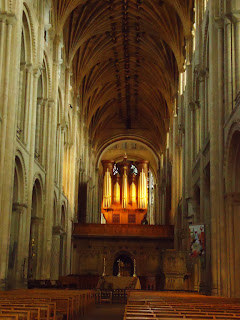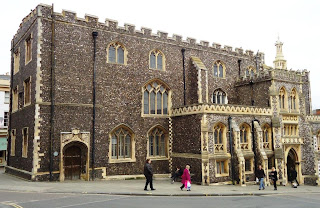When we went to Norfolk and Suffolk last year, the family dropped me off at Norwich station to make my way back to London for work while they continued on for a bit longer. This left me with a niggling sense of not having seen or done this city, a situation I wanted to rectify. So, I bought train tickets and set off early Saturday morning so that the family had to wave me goodbye for a change! (Only they didn't because Aisha and William slept in!)
 |
| Colman's mustard museum and shop |
Mustard is a summer seasonal crop grown for its potent seeds since Roman times. The fields and fenlands around Norfolk are apparently full of it because English mustard has made such a name for itself. In the early 19th century Jeremiah Colman, a flour miller, took the idea of milling mustard and turned it into an industry. He blended both brown and white mustard seeds to create a distinctive strong and distinctly English mustard. James’ son Jeremiah James Colman later took over the company. He was a visionary, and his ideas on employment and social welfare were years ahead of his time. He built a subsidised school for his employee’s children almost twenty years before parliament made any form of education compulsory and employed Philippa Flowerday, one of the very first industrial nurses, to help sick employees.
 |
| lost in the Norwich Lanes shopping! |
 |
| Second longest nave in England |
Norwich Cathedral is one of many churches (91 if I remember rightly) built when the city was second only to London in importance. It is another amazing English cathedral, begun in 1096, and one of the finest Anglo-Norman abbeys in the country. The nave is the second longest in the country while the spire soars higher than any other in England apart from Salisbury Cathedral. Unusually, most of the stone structure is still original. The most famous feature is the ribbed vaulting added in 1463 after the original wooden one was burnt down. The unique rosettes along its length tell the story of the Creation, the only ceiling of its kind.
 |
| Norwich cathedral's unique vaulted ceiling |
 |
| Jesus - knobbly knees ascending |
The reredos, an ornamental screen covering the wall at the back of an altar, is one of the most valuable treasures in the cathedral and has a wonderful story to go with it. Apparently when the Puritan reformers came through the church during the Civil War the inside of the cathedral was destroyed, the window glass was smashed, the wall paintings defaced, the vestments and books stolen, the tombs and monuments defaced or demolished and gunmen filled the cathedral drinking, smoking and shooting. Cromwell was asked by the Puritans of Great Yarmouth whether they could pull the cathedral down so that they could use the stone to strengthen their harbour and build new workhouses. Thankfully Cromwell refused! Fortunately in all this chaos, someone had the forethought to turn it upside down, add some legs to it and turn it into a table! It continued to be used as a table, for centuries, forgotten and undiscovered until last century when a meeting was held and someone who knew what he was looking at, dropped his pen on the floor and saw what was on the underside of the"table." What I particularly found amusing was the panel with the ascension on it - how unbecoming to be Jesus and be raised to heaven, only to have your knobbly knees the only part of you recorded!
 |
| The beautiful Peace Globe |
 |
| The font used to be used in for making chocolate in the Norwich Cadbury's factory. When closed the equipment was refashioned and donated to the cathedral. |
 |
| The pelican lectern is biblically significant. In myth the pelican is said to feed her young from the blood of her own breast. |
 |
| King Edward I |
 |
| Queen Eleanor |
The following morning after a good "Full English" breakfast, I wandered along the Riverwalk in the fog, enjoying the snowdrops and crocuses that were coming up to show spring is on its way.



Cow Tower was built in 1399, one of the earliest purpose built artillery blockhouse built to defend a strategic point in Norwich's defences on the River Wensum. It was able to house guns and the new cannons.
Along the river I came across Norwich's last swan pit and one of the last in the country. In medieval times swans were reserved for the table of the king and a handful of privileged nobles and clerics. St Giles’ Hospital acquired the right to herd swans soon after its foundation so established the purpose-built confined area, the swan pit. Two creeks extended into the hospital's precinct from the south bank of the River Wensum. At least one of them was navigable and small boats were able to travel within yards of the buildings in order to unload food, fuel and building supplies. One of the creeks fed fish ponds and would have attracted many swans, which in Stuart times continued to be protected (Nicholas Salter was locked up in Norwich for three months for destroying a swan’s egg in 1664!)
Every person or institution in Norwich that had the right to keep swans had to mark their swans with a distinctive sign lightly cut into its beak. In August each year a ‘swan-upping’ took place on the river when ownership of all of the cygnets was established. A chart in the Refectory shows 72 of the marks used in Norwich, some of them belonging to the Hospital.
Every year the hospital sent a swan to Sandringham Palace as a gift to the king. The pit was in use until WWII when it was forced to close due to the grain shortage. By this time the hospital had been supplying oven-ready swans for the tables of the rich all over the country and live swans too, dispatched by rail, travelling in wicker baskets.
 |
| A dovecote - beautiful now but in medieval times pigeons and doves were an important source of food and possession was a privilege only permitted for nobles |
 |
| The last swan pit |
 |
| No matter what the weather, Englishmen go fishing! |
 |

For the rest of Sunday I wandered more, found some great shops to look around in, bought some clothes and a pair of shoes (don't tell Mark!). The names of the streets and alleys were quite different and often amusing - Upper and Lower Goat Alley, Pottergate, Back of the Inns, Gentlemen's Walk, Cattlemarket Street - telling the story of times past.
After a wander around the Norwich castle I hopped back on the train for an easy 2 hour trip back to London.

So, a very good weekend!
And now I have done my first blog. Thank goodness for Mark - if it had been left up to me, this would be the only record of our more than 2 years in the UK!
As I write, he and the children have made it to Tignes Ski Resort in France where they will be happily skiing until next weekend. Stay tuned for another blog soon!!





No comments:
Post a Comment